This is Greenfield Village and the Henry Ford Museum in Dearborn, Michigan.
Henry Ford, founder of the Ford Motor Company, had always had an interest in collecting historic objects, and with the huge wealth he acquired from his car company, he was able to indulge that interest. In 1919, he decided to restore the wooden farmhouse where he was born and lived until he was 16, as a memorial to his parents. This restoration was the first that Henry Ford attempted, and began a life-long effort in preserving and restoring historic properties from around the nation and the world.

Mr. Ford also developed life-long friendships with many of the era's most famous and influential inventors and creators: George Eastman (of Eastman Kodak), John D. Rockefeller, and Orville Wright, among many others, but none perhaps was as important as his friendship and near worship of Thomas Edison. Mr. Ford's appreciation of Mr. Edison's contributions, along with his developing passion for historic preservation, led to the creation of one of this nation's most important repositories of historical objects and structures — Greenfield Village and the Henry Ford Museum, jointly known as the Edison Institute.
A large tract of land in the middle of several Ford Motor Company facilities was set aside for a massive historic development, one that became what I consider America's first "theme park." It was dedicated on October 21, 1929, the 50th anniversary of the creation of the electric light, and Thomas Edison was there for the dedication. Since then, this remarkable collection of millions of historic artifacts, engineering achievements and famous structures has grown and evolved into one of the nation's most distinguished and popular museum complexes. Even the name has changed — it is now known simply as The Henry Ford.
The first structure seen by visitors arriving at the complex is the massive Henry Ford Museum. Covering 49,000 square meters, or about twelve acres, this structure is one of the largest museums in the country and contains a staggering variety of attractions and exhibits. The main entrance of the museum is a careful recreation of Independence Hall in Philadelphia, flanked by a symmetrical procession of brick colonial-style structures. When the museum was being designed, Mr. Ford sent architects to Philadelphia to study and measure the original Independence Hall, and while there, they discovered that one of the windows was actually off-center. It had been placed one brick too far to one side. The architects told Mr. Ford what they had found and informed him that they would not make the same mistake — and he instructed them to recreate it exactly like the original, misplaced window and all.

Behind this long historic panorama are found restaurants, gift shops, an IMAX theater and many other visitor support facilities, but most important are the wide hallways leading back into the huge main body of the museum. It is difficult to conceive just how large this space is. It is not divided up into galleries or rooms like so many museums are — it is one huge exhibition hall, with massive columns supporting soaring arches that stretch far off into the distance. The size and scope of the hall could be overwhelming if it weren't for the brilliant exhibit designers and their grouping of attractions by theme. Using a plan similar to the now-well-known themed lands in today's theme parks, the museum is organized into sections that allow visitors to explore areas of special interest either in detail or in general, depending on their personal desire and how much time they have.
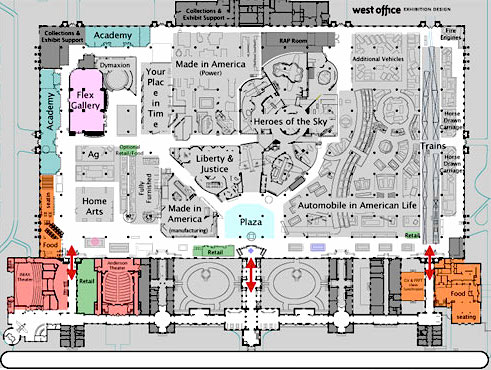
More than a dozen themed areas, containing thousands of exhibits, are found in the museum. Some are what you would expect in a museum named after Henry Ford, pioneer of the modern transportation industry, but others show the depth and imagination that the museum designers have in showcasing the development of the American way of life and how technology drove that development. A few examples are:
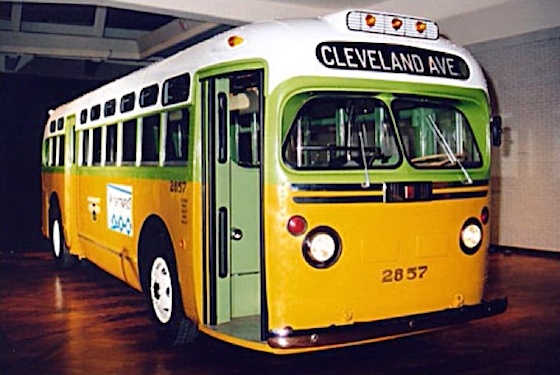
The Henry Ford Museum places special importance on the preservation and presentation of important historical and cultural artifacts. The following list is just a small sample of some of the priceless historic exhibits that can be viewed here:
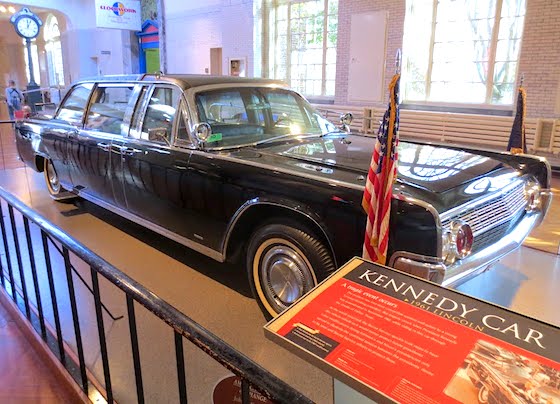
Not all of the displays are serious and of historic importance. Many are also displays of popular culture and its influence on our daily life. Some of these displays include:
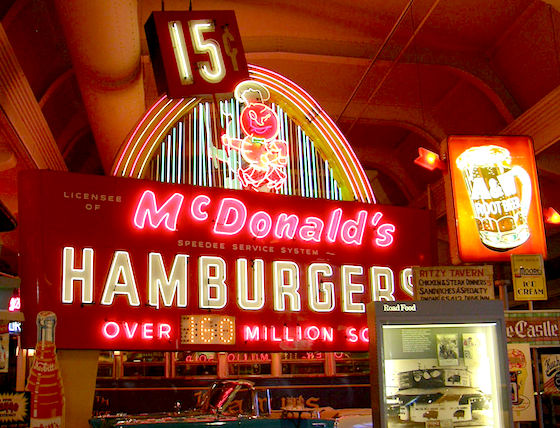
Special exhibits are often featured in the museum. Right now visitors can explore "Gridiron Glory: The Best of the Pro Football Hall of Fame" until Jan. 4th, 2015, and past displays have featured artifacts from the Titanic and even a remarkable collection of the artwork of the Disney theme parks. Constantly changing programs for children provide a place for future inventors, designers and artists to discover their inner talents.
Historic airplanes are suspended from the ceiling. Early American furniture from rustic homemade chairs to the finest Chippendale can be seen. A completely restored Dymaxion House, designed by R. Buckminster Fuller in 1946 as the strongest, lightest, most cost-effective house ever built can be walked through (it is the only one still in existence). A visitor would be hard-pressed to not find something to catch their attention somewhere in the seemingly endless variety of displays to be found in this remarkable museum.

As a free-standing museum, the Henry Ford Museum would be a world-class destination by itself, but right next door to it is the place that I truly believe is the first theme park in America — Greenfield Village. Henry Ford wanted to preserve not just objects or things, but in his own words:
"I am collecting the history of our people as written into things their hands made and used.... When we are through, we shall have reproduced American life as lived, and that, I think, is the best way of preserving at least a part of our history and tradition."
He decided that, to appreciate the importance of the objects he had collected, they had to be seen in the original setting where they were created and used. To this end, he began to assemble structures from all over the nation, and in some cases the world, bringing them to Dearborn, Michigan and creating his own village filled with homes, shops, factories, and even complete farms. The 1920's, when he began this endeavor, was when the concept of historic preservation of buildings was just beginning to be considered important. Many of the buildings that he acquired and brought to Greenfield Village were in a sad state of disrepair, their importance forgotten and their physical structure neglected. Had Mr. Ford not had the vision to see the importance of these structures (and the financial ability to rescue them) many if not most of the buildings now standing in Greenfield Village would have been lost to us.
This collection shows how far-sighted Henry Ford was, and why I would argue that Greenfield Village was the first theme park in America. He designed it as an actual village, centered on a beautiful village green with streets leading to residential, commercial and industrial neighborhoods. The village itself covers 90 acres, with another 150 acres of forest, pasture and river surrounding much of the village and acting both as a buffer against the outside world intruding on the historic atmosphere and providing pasture land for the many farm animals used in the Village. A tall brick wall surrounds the grounds, both for security and to act as a further buffer, much like the famous "berm" at Disneyland protects the park from the surrounding urban sprawl.
The similarities of the Greenfield Village layout to modern theme park design is quite remarkable. After passing through the main entrance plaza, where tickets can be purchased, guest services are provided and a large gift shop can be found, visitors pass the tracks of the Weiser Railroad that circumnavigates the Village and proceed down a village street lined with historic structures towards the Village Green (the "hub" of the village) with the beautiful Martha-Mary Chapel standing on the highest spot in the village. The soaring steeple acts as a focal point to the entire village, similar to the use of other iconic structures in more modern theme parks.
The Green is surrounded by historic buildings typical of the kind that would have been found in thousands of villages around the nation. The circ. 1831 Eagle Tavern, the Town Hall, the Logan County Courthouse from Lincoln, Illinois (where, from 1840 to 1847 a young lawyer named Abraham Lincoln argued cases, usually involving land disputes), the one-room Scotch Settlement School (which Henry Ford attended), and the circ.1858 J.R. Jones General Store all can be found here, all open to visitors and all designed to bring the daily events of the 1800s to life.
Radiating away from the Village Green are the streets of Greenfield Village, some long, straight avenues that seem to disappear into a rural distance, others that curve and turn as if following a long-forgotten Indian trail, and still others that end at the next cross street — in other words, the streets of a typical American village. This layout is not meant to herd visitors to the next attraction nor to funnel them to the exit at the end of the day — it is meant to encourage exploration and discovery of the village and its wonders. It may sound a bit confusing, but there is something familiar and comfortable about wandering through Greenfield Village, as though a visitor is remembering a time in their past when this layout was nothing special or unusual, just normal.
Here we come to another facet of Greenfield Village's design that predates the "themed lands" of Mr. Knotts and Mr. Disney by decades. Henry Ford grouped his structures together into neighborhoods, where structures with similar functions were often found together. These neighborhoods are now described as Historic Districts, and there are seven of them to be found in Greenfield Village. Each is unique, yet each seems to flow seamlessly into its neighbors. There are no overhead signs, no changes in music, just the normal transition where you subtly realize that you are in a different part of town. I won't list every building in each District — that would turn this article into a guide book — but I will mention the most significant buildings and perhaps something special or unique about their history and significance to Greenfield Village and our nation's history.
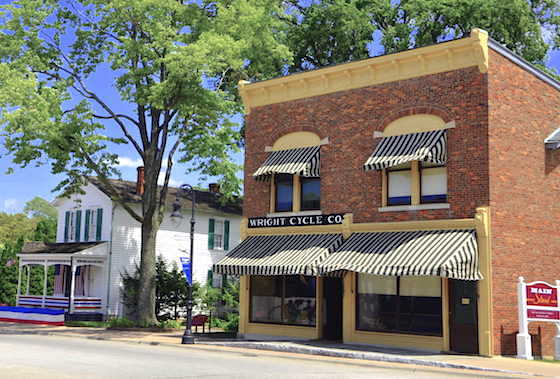
Main Street: This area is the Historic District that surrounds the Village Green and was described earlier. Two important structures not mentioned previously are the Wright Brothers Home and Cycle Shop, brought to the Village from Dayton, Ohio. Wilbur and Orville Wright lived in the home from 1870 to 1913. The income they earned from running the cycle shop next door allowed them to finance their early aviation experiments, and the knowledge they gained in understanding mechanics made possible their creation of the first airplane. Also found in this District is one of the most popular attractions in the Village — Gog and Magog, wooden statues that form part of a nearly 150-year-old mechanical clock that once stood five stories above a London street as part of the Sir John Bennett Shop. The new version of this shop, now standing just two stories tall, attracts visitors all day long as they fill the park benches that face the shop and wait for the quarter hour, when Gog and Magog ring the bells that hangs in the middle of the clock.

It might seem primitive compared to the high-tech audio animatronic creations found in modern theme parks, but visitors love the chance to get an ice cream cone from a nearby ice cream stand, sit and rest their feet, and enjoy the historic and entertaining atmosphere.
Railroad Junction: A fully-functional railroad roundhouse from 1884 contains several historic steam locomotives. Nearby is the 1858 Smiths Creek Depot, a train station where a young newsboy names Thomas Edison sold candy and newspapers. This District demonstrates the importance of the railroad system to the creation of a rapidly-developing industrial nation.

Working Farms: Greenfield Village is so large that the fully-functional Firestone Farm was brought here in 1985. It includes the 1828 home ("modernized" in 1882) and the surrounding farm buildings, including a large barn. Fields of crops and pastures for the grazing of animals line a long road as visitors approach this classic example of American rural life. Harvey Firestone, of Firestone Tire fame, grew up in this home, which is interpreted as a living, working farmhouse. You will often find a "family" of living historians cooking and sharing meals in the kitchen.

Edison at Work: This area is not so much a restoration but a recreation of Menlo Park, Thomas Edison's research center, where the great inventor created the electric light, phonograph, and so many other historic inventions. Detailed research on the original site and the salvage of the remaining structures make this one of the most important districts in all of Greenfield Village.

Porches and Parlors: This is the residential district of Greenfield Village, and the list of important homes that now stand here would require an article of its own. The following list is just a sample of what can be found in this District:
This list is just a sample of the many historic homes that line the streets of the Porches and Parlors Historic District. From elegant Colonial mansions to stark slave quarters, the history of daily American life can be discovered in this remarkable area.
Liberty Craftworks: Here visitors can watch glass being blown, pottery being created, wood being turned from logs into furniture, and nearly a dozen other crafts that were so essential to the change of America from an agricultural nation to an industrial power.
Most of these structures are historic buildings brought to Greenfield Village from towns all over Michigan, and many of these craft shops create goods that can be purchased by visitors.
Henry Ford's Model T: The life of Henry Ford can be discovered in this District, including Mr. Ford's first preservation effort, the wooden farmhouse where he was born in 1863. This simple home and some of its surrounding structures were brought to the Village in 1944. Nearby stand replicas of the buildings where Mr. Ford created his first automobile and established the Ford Motor Company and its revolutionary production line method of building cars.
There was one more public area of Greenfield Village, Suwanee Park, that no longer exists as a Historic District. From about 1973 until 2003 this area was an attempt to recreate a Victorian-era amusement park. It contained an ice cream parlor, a 1913 Herchell-Spillman carousel that came from Liberty Lake, Washington, an arcade containing antique penny arcade machines, a large open field used for special events such as Civil War re-enactor encampments, and the dock for a steam-powered paddlewheel boat, the Suwanee, that took visitors around a large island created from a curve of a nearby river.
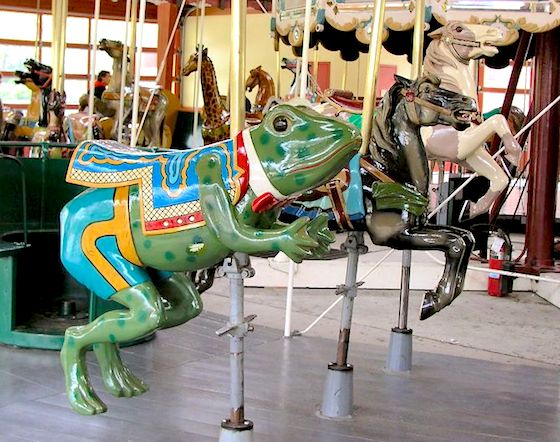
This area never really grabbed the public's attention like the rest of Greenfield Village did. It was not part of Henry Ford's plan, and had no truly historic buildings. Its location was inconvenient and often overlooked by visitors, and its attractions were of somewhat limited interest. The games in the penny arcade never seemed to work and the food at the ice cream parlor was adequate at best and mostly unmemorable. In 2003 the Herchell-Spillman carousel was moved to a new building in the Main Street Historic District, the Suwanee paddlewheeler was dismantled, and the Henry Ford Academy, a charter school, took over the buildings and now has an enrollment of nearly 500 students.
Many weekends find Greenfield Village taken over by special events, many of which could not be held properly at any other theme park. These events are extremely popular with visitors, and often find the Village extending its hours into the evening (from its usual closing time of 5pm). Some are similar to special events found at other parks, while others are unique to Greenfield Village. Regardless, each event attracts thousands of families from throughout the region to enjoy and experience them. Some examples of these events include:
Holiday Nights: Visitors find the entire Village adorned with period-appropriate decorations, an ice-skating rink, lanterns lining the streets, carolers performing, and fireworks celebrating the holiday season. A Christmas tree in the Wright brothers' home recreates one found there from a photo taken while they lived in the house.
Old Car Festival: This event is the longest running antique car show in the world, featuring hundreds of automobiles from the 1890's to 1932.
Motor Muster: Complimenting the Old Car Festival, the Motor Muster features vehicles of all types from 1930 to the 1970's including muscle cars, vintage trucks, motorcycles, and just about every other type of motorize vehicle that can be imagined.
Ragtime Street Fair: This celebration of ragtime music features live performances throughout the Village and special foods not found any other time of the year.
Historic baseball: Most weekends find baseball games being held between area baseball teams that use the original rules of 1867: The "Striker" (batter) told the pitcher where he wanted the ball to be thrown; gloves were allowed (but frowned upon as being "unmanly") and didn't have fingers; there was no pitcher's mound. Every year the World Tournament of Historic Baseball is held on the Walnut Grove baseball field (located near the old Suwanee Park) and attracts dozens of historic baseball teams from around the world.
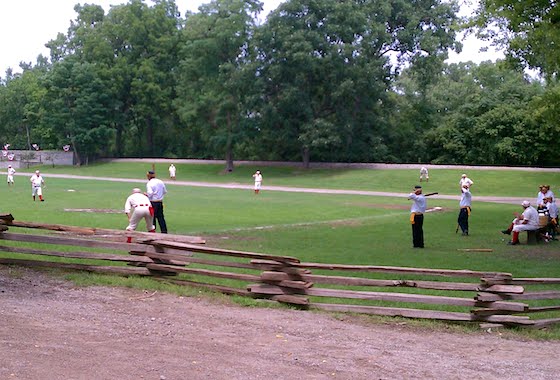
Much is discussed about the quality and variety of food in theme parks. Greenfield Village has a claim for some of the best and most unique food choices of any park. From a nearly two hundred year old stagecoach stop and tavern to an early food truck, the variety, selection and quality of the food items available here is unmatched. Some examples of these choices are:
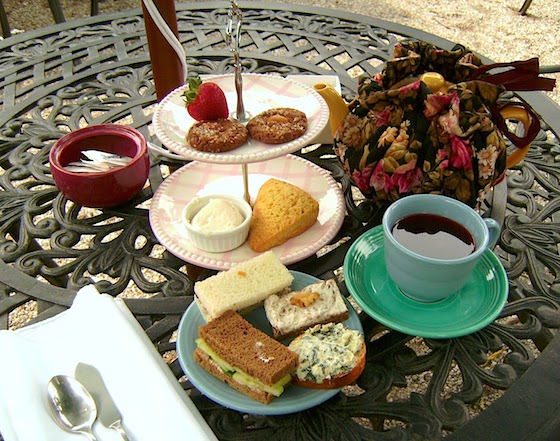
Greenfield Village almost begs to be explored on foot, but the size of it can take a toll on the feet of many visitors. It is appropriate that a theme park made possible by the automobile industry has a variety of transportation choices to increase the fun of a day at the Village and give tired feet a rest. For an extra charge, visitors can travel around the Village using:
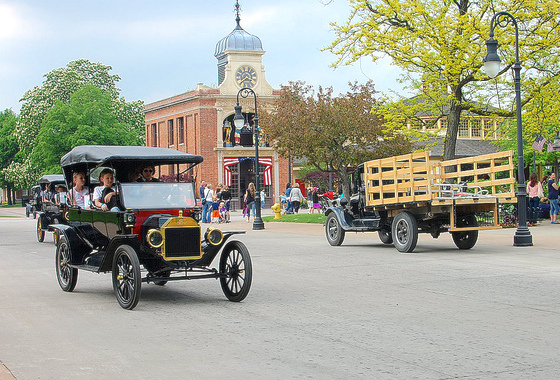
Each of these transportation methods make stops throughout the Village.
Greenfield Village is open daily from mid-April until the end of October, on Fridays and Weekends until the first of the year, and is closed during the winter from January until mid-April. Hours are usually 9:30am to 5 pm, with some extended hours on selected evenings for special events. Admission includes all open structures and Historic Districts.
The Henry Ford is a remarkable institution. The Henry Ford Museum is a world-class facility that celebrates human ingenuity and creativity. Greenfield Village shows how that creativity was used in everyday life, transforming America from an agricultural nation to an industrial powerhouse while improving the lives of its citizens. A visit to this historic place, America's first true theme park, is a unique experience, one that is educational, enlightening, and most importantly, fun.
You Might Also Like:
Tweet
Unfortunately, I doubt we would ever deliberately plan another trip to the Detroit area (been there done that), so it might be a long time before we ever get a chance to experience Greenfield Village.
Oh, and I loved it!
This article has been archived and is no longer accepting comments.